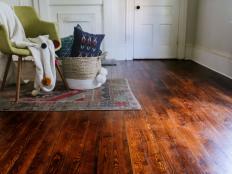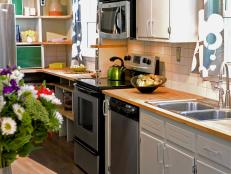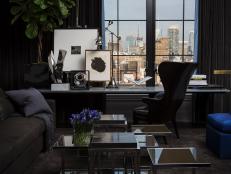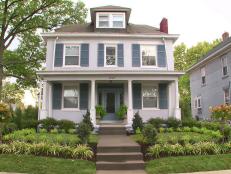4 Steps to Staging for an Open House
Give your home the "wow" factor it needs to impress potential buyers.


Holding an open house can be a great way to get your home for sale noticed -- that is, if your home is in good condition. If not, well...
"I have personally witnessed people who have walked into a house, turned around, and walked back out," says Alice T. Chan, a professional stager in San Francisco.
If you're even thinking about selling your home, chances are you've heard of "staging," or the process of preparing a home for sale via de-cluttering, depersonalizing and neutralizing, among other techniques. If you want to avoid an open house snub similar to the one described above, staging, repairing and generally prepping your home for sale is a must in today's market.
"Buyers really want turn-key these days," Chan says. "If a buyer can actually get a loan right now, they're so strapped after they purchase a property that they literally just want to move in and live. Even if they want to make upgrades later on, they want to feel like they're getting the best value possible. So give it to them."
So how do you make your home open-house ready? Depending on your home's current condition, it can be a large, overwhelming job, so you'll want to stay organized, take it slow and work step-by-step.
Step 1: Plan and Prioritize
You definitely don't want to start preparing for your open house by making updates willy nilly. Before getting started, it's important to understand what improvements will help you sell your home and to make a realistic plan that fits your budget and time frame. Ilaria Barion, a professional home stager in New York and Chicago and author of Set the Stage for a Sale, offers three tips to get you started:
- Let go emotionally. The moment you put your house up for sale, it becomes a product, Barion says, so you have to train yourself to stop thinking about it as your home. "What I suggest sellers to start doing is calling it their property instead of their home," she says.
- Identify the target audience. Think about what kind of neighborhood you live in. Is it young and hip and filled with first-time buyers, or is it mature and established with lots of families? It's important to know what type of buyer you're targeting so you can stage accordingly. For instance, if you live in a neighborhood that's popular with first-time buyers and your home hasn't been renovated since 1977, you'll want to strip the wallpaper and remove the dated draperies to appeal to young buyers. If you live in an upscale neighborhood, buyers will expect certain high-end features and upgrades. Your real estate agent can help you determine what's standard in your area.
- Determine what buyers want. Barion believes homebuyers are looking for three things: an emotional connection with the home, value for their money and move-in ready conditions. As you're preparing your home, think about these factors, because you have a lot of control over them. For instance, a buyer will not be able to envision themselves living in your home if your family photos are plastered all over the walls, but you can easily fix that.
Keeping your target buyers and what they are looking for in mind, your next step is to grab a pen and paper, walk through your property as a buyer would and jot down your home's problem areas, Chan says.
"Really be hard on yourself," Chan says. "Look through the buyer's eyes as much as you can. If you can't be objective, bring someone along you who will tell you exactly like it is, not just what you want to hear."
Once you've finished your list, rank it, putting top-priority issues that are sure to turn off buyers first. Depending on your budget and time frame, it may not be feasible to address everything on your list. But remember, today's buyers are looking for move-in ready properties. Putting a little more time and money into updates could lead to a quicker sale and a higher sales price.
Step 2: Tackle Big-Picture Projects
When you made your list, you likely found some broad issues that apply to your entire home, like worn-out carpeting or chipped paint. Or perhaps your home seems cluttered and dated in general, a quality that will make it hard for buyers to envision your home as their own. These large problems can seem daunting to fix, but they're the ones that buyers will certainly notice during your open house. Here are some general fixes you should definitely consider making:
Cleaning
This is a no-brainer. If potential buyers walk into your open house and see dust on the coffee table and soap scum in your showers, say goodbye to your chances of making a sale. Cleaning your home from top to bottom is a cheap and (relatively) easy way to make your home show much better during your open house. Pay special attention to your kitchen and bathrooms -- those tend to get dirty the fastest.
De-cluttering and Depersonalizing
Personal items like family photos and knickknacks are distracting and need to be put away before your open house. Just think of it as getting a head start on your packing. Don't forget to clean out and organize closets and storage space. Buyers will look there too, and messy, overflowing closets give the impression that your home doesn't have enough storage space. Removing seasonal items -- like winter coats and holiday decorations if you're selling in the spring -- is a good place to start. You can also pack up and donate items you have in duplicate and clothes and toys your kids have grown out of.
Fixing What's Broken
Remember all the little home maintenance projects you've been putting off for years? Now's the time to do them. Make sure all broken windows, leaky faucets and nonfunctioning light switches are in working order before your open house.
Painting
A fresh coat of paint on your interior walls is by far one of the most cost-effective ways to make your home show well. When choosing a paint color, think neutral (warm beige or pale green), not bland (stark white). Whatever you do, don't just leave your bright magenta bedroom as-is. You may love it, but most buyers won't feel the same way.
Paint can also work wonders on outdated or cheap cabinetry. Just rolling on some paint can instantly update your kitchen and make it look more high-end.
Replacing Flooring
Flooring is an important update that sellers are often reluctant to make. Some sellers choose to offer a credit instead of replacing their flooring, but Chan says that's not an effective strategy.
"Giving buyers a credit is not going to have the same effect as doing it for them because they only know what they see, and they focus on the negative," Chan says.
Try cleaning your flooring first, but if it's worn or stained beyond repair, replace it. You don't have to go with top-of-the-line options here unless you're selling a high-end home. Any neutral-colored carpet or even peel-and stick linoleum tiles for a kitchen or bathroom will make a big difference.
Updating Light Fixtures Light fixtures are the jewelry of a home, Chan says. "They really make a big difference, and they're also one of the first things to date a property. You can pretty much tell when a house was built or when it was last renovated by the type of light fixtures that are in it," she says.
So what can you do about those circa-1986 brass chandeliers? You could buy some inexpensive, contemporary fixtures, or if you're really on a budget, you can simply revamp your old fixtures with a can of spray paint.
Step 3: Hone in on the Details
Now that you've tackled the big projects, the hardest and most expensive part is out of the way. The next step to getting your home open-house ready is to "dress it up," and luckily, you can often do this by repurposing what you already own and adding small details. Working room by room is a good strategy on this step -- it's less overwhelming, and you'll feel more and more accomplished after each room you finish. Use these tips to fine-tune each room in your home:
Front Yard and Entryway
Even though it's not actually a room, don't overlook these areas. Sprucing up your yard and your home's entrance is essential because it's the first thing buyers see, so you need to impress them off the bat.
- Keep your lawn mowed and well-maintained. Consider hiring someone to take care of this for you while you're dealing with the other details of selling.
- Plant some bright, colorful flowers.
- Replace a grungy, old welcome mat with a clean, new one.
- Give the front door a fresh coat of paint.
- Replace old, faded house numbers with new ones.
- Clean out your gutters and pressure wash your home's siding. If your home's exterior isn't well-maintained, buyers will think you've slacked off throughout the rest of the house as well.
Living Room
The living room (or the first room buyers see when they enter your home) is another one that needs to have the "wow" factor. Generally speaking, less is more when it comes to living rooms. "Most people have more than enough things, so it's really about editing what you have and moving things around," Chan says.
- Remove large furniture, like huge sectional sofas.
- Arrange furniture to create a focal point, perhaps around a fireplace or a large window.
- Don't push your furniture all the way against the walls.
- If your sofa or chairs are not in great shape, disguise them with slipcovers or luxurious throws -- a much cheaper option than buying brand new furniture.
Kitchen
"Kitchens and the bathrooms never look good naked; they always look better dressed up," Chan says. Once your kitchen is spotlessly clean, give it some style.
- Remove magnets and photos off the refrigerator.
- Clear off your countertops, except for the essentials. "If you use your coffee machine every day, it's OK to have it out on the counter, but you don't want your countertops to be a display of every small appliance you own," Chan says.
- Add stylish accessories, tying them together with a theme, Chan suggests. For instance, you could go with a pasta theme and decorate the space with an Italian cookbook, decorative bottles of oil and glass jars filled with colorful pasta.
- Use greenery to fill in empty corners and add color.
Bedroom
A good rule of thumb when staging your bedrooms is to emulate a hotel room -- emphasize luxury and comfort.
- Turn your master bedroom into a proper master bedroom: no extra beds for the kids, no workspaces, no everyday, nice-to-have things that don't really belong in a bedroom.
- Cover your everyday bedding with luxurious bedding or a nice throw. You don't have to spend a lot of money here -- discount stores have plenty of inexpensive options that look high-end.
- If your mattresses are sitting on the floor, buy or rent bed frames to lift them up.
Bathroom
Like the kitchen, your bathrooms will show a whole lot better with a little bit of style.
- Put away your everyday towels and replace them with new towels. Also add a new shower curtain and fresh, fancy soap.
- Hide toothbrushes and other toiletries in baskets or other storage containers. This keeps them easily accessible, but lets you stow them away quickly before an open house.
- Dress up the space with some candles or a silk flower arrangement.
Backyard
For many people, the backyard serves as a dumping ground. Clean this space up and make it a place where buyers can see themselves spending time.
- Add furniture -- a bistro table and two chairs for a smaller area or a dining set for large yards.
- Stage it as a place for entertaining. Set out a tray with a pitcher of lemonade, or put out some coffee and bagels for a breakfast scene.
Step 4: Put on the Finishing Touches
It's here: the big day of your open house! Your home should be in tip-top condition and ready for potential buyers. Don't forget these last-minute details:
- Set out vases of fresh-cut flowers. They'll make your home smell nice and add a splash of color.
- Let in the light. Buyers want a bright, open house, not a dark and dreary cave. Turn on all the lights and open all the curtains.
- Adjust the temperature. Keep the home comfortable -- not too cold or too hot.
- Serve food and drinks. A cold glass of lemonade in the summer or some warm, freshly baked cookies in the winter will encourage buyers to stick around longer, giving them more time to check out your home.
- Safeguard your stuff. Stash valuables and prescription medications in a safe place.
- Leave! You're probably proud of how fantastic your house looks right now, but don't stick around to point this out to buyers. The last thing you want to do is make them feel uncomfortable. Spend the day out and about and let your perfectly prepped home sell itself!














































